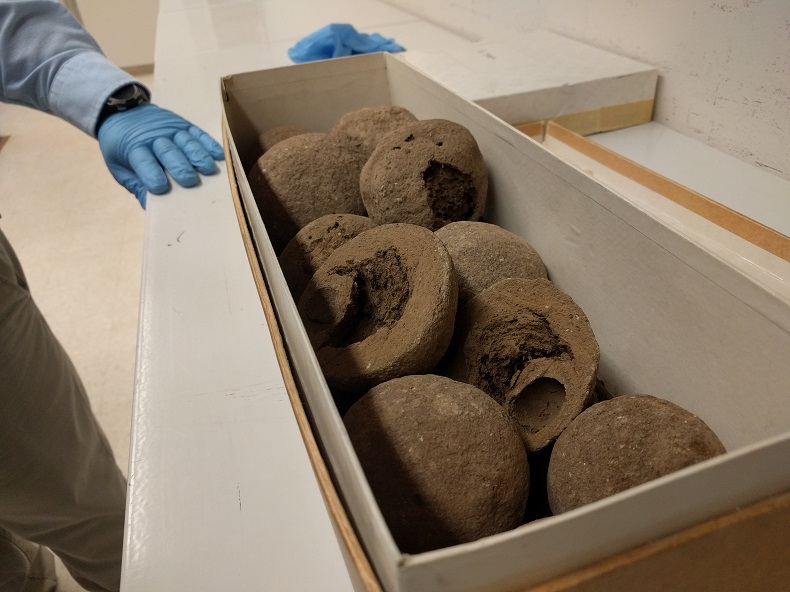
In the summer of 2011, the Smithsonian’s National Museum of Natural History was in the process of doing some bug relocation. Specifically, they were moving some of their beetles from the museum building downtown out to a storage facility in the suburbs—specifically, the non-plant-eating scarabs.
It was a lot of scarabs. The museum has a lot of bugs and a lot of them are beetles, and 696 drawers full of them were being moved. In the last cabinet, at the bottom, collections manager Floyd Shockley noticed an odd box—not any of the standard containers that the museum uses to store bugs.
Inside were the brown, dirty balls pictured above. An abandoned papier-mache project? Nuts? Hairballs?
None of the above. Shockley, who is a beetle guy, knew instantly what they were: poop.
Specifically, they were dung balls. Hard-working scarabs had rolled this poop into nice solid baseball-sized spheres to lay their eggs in. When the offspring hatched, not only were they cozy and warm, but they were absolutely surrounded by food. Tasty, tasty undigested material from elephant poop. Some of the dung balls had been sliced in half at some time in the past, so you can see where the larvae started eating their way through their homes.
When Shockley found the dung balls, he had no idea what they were doing in the entomology collection—of all those drawers and drawers of scarabs Shockley helped move, these were the only balls of poo.
I saw these dung balls Tuesday evening as part of an event the museum’s communications team put on for some local science writers. We took a quick lap through a new exhibit that opens today, Objects of Wonder, which is about the millions and millions of objects the museum owns—blocks of wood, bright blue berries, animals collected by Teddy Roosevelt. Then we were herded behind the scenes—always a delight, those low-ceiling, cabinet-filled archives of dead stuff—and museum employees showed off some of their treasures.
One of Shockley’s treasures: the box. And, inside the box, a handwritten note, in pencil on browned paper, with these words (transcribed by Shockley):
Heliocopris sp. (Sz. det
bolls [sic] from tombs in desert
near Lisht, (30 mi S. of Cairo
& 3 mi W. of Nile Riv.) Egypt
Hrdlka.
Egypt? Tombs in Egypt? That Egypt? Shockley checked around and found out that the pyramids near Lisht were from the Middle Kingdom, 1800-2000 BCE—which makes them somewhere in the range of 3800 to 4000 years old.
Shockley pulled on gloves before picking up one of the dung balls, and while he held it up and told us the story about finding the box, I kept nervously imagining the ball falling from his hand and smashing on the museum floor. Nearly 4,000 years ago a beetle carefully shaped that ball of elephant poo, then laid her eggs in it, then someone put it in a pyramid–are scarabs helpful in the afterlife?–and now here he was, holding it in his blue-gloved hand. He still doesn’t know how the dung balls ended up in the entomology collection. Some day maybe he’ll open one up to find out what species the larvae are. For now, though, they rest in their antique box, deep in the non-public areas of the museum.
The final step: Shockley held up the ball and walked through the ranks of science writers, crowded into the aisle at the end of a moth-ball-scented room full of dead insects. Holding the ball up to roughly ear height, he shook it back and forth, and I heard it: the rattle of dried-out scarab larvae, millennia after their time.
Photo: Helen Fields
Huge thanks to Floyd Shockley for digging up an old draft of a story he’d written about these but never gotten around to posting, which I relied heavily on for my facts.
Is Floyd related to the Shockley of transistor and ceiling fame?